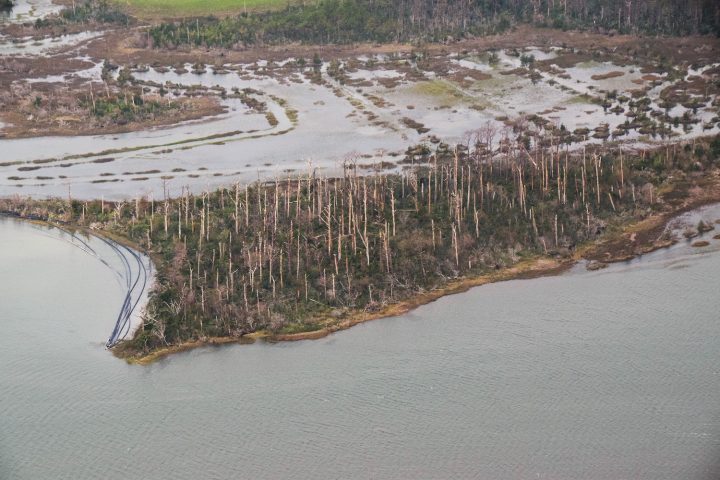
NEW BERN – The next five-year update to the state’s 2010 sea level rise assessment report will look all the way out to 2100, the science advisory panel to the state Coastal Resources Commission decided during its Oct. 18 meeting.
The CRC Science Panel’s 2010 North Carolina Sea Level Rise Assessment Report, which included sea level rise projections to 2100, was updated in 2015 but commission members in place at the time limited the panel’s scope to a 30-year rolling time table.
Supporter Spotlight
The 2010 report was a synthesis of then available data on sea level rise on the state’s coast. It also provided recommendations, at the request of the CRC, regarding how much sea level rise to plan for by 2100. The conclusion for that report was “that a rise of 1 meter (39 inches) be adopted as the amount of anticipated rise by 2100, for policy development and planning purposes.” The panel also recommended that the report be updated every five years to stay current with the latest science.
The report was met with scorn by a North Carolina economic group, ultimately leading to Session Law 2012-202, House Bill 819, which gave guidelines to the sea level rise report’s 2015 update and also included that the CRC and DCM “shall not define rates of sea-level change for regulatory purposes prior to July 1, 2016.” North Carolina faced national criticism as a result, with many news sources saying that the state had outlawed science.
The current CRC members for the 2020 update directed the science panel during its September meeting to “conduct a comprehensive review of scientific literature and available North Carolina data that addresses the full range of North Carolina-specific sea level change and to look ahead “a minimum of 30 years.”
Tancred Miller, coastal and ocean policy manager with the Department of Environmental Quality’s Division of Coastal Management, told Coastal Review Online that having the report extend to 2100 is to help inform decision making on longer-term investments. Also, 2100 is a benchmark date that is used in a lot of the published literature.
Miller said the commission members at the time went with the 30-year timeframe for the 2015 report because they thought it would be more relatable.
Supporter Spotlight
“Thirty is a common number in our rules and people are comfortable with it. Oceanfront setbacks are 30 times the annual erosion rate, the estuarine buffer is 30 feet and it ties in neatly to a 30-year mortgage,” he said. Additionally, the range of uncertainty in the projections is much lower at 30 years than at 85 years. “For these reasons they thought a single time step to 2100 wasn’t as useful for planning as a 30-year projection. That’s also why the commission asked for 30 years plus whatever else the panel wants to add beyond that, for the 2020 report.”

Bill Birkemeier, chairman of the 10-member CRC Science Panel, in a follow-up interview said that the meeting Oct. 18 in New Bern was the first with the newly appointed panel members and the first meeting to begin thinking about the sea level rise report update.
“Although there are many sources of sea level information, it was clear that one focusing on North Carolina was still needed. We will be busy,” he added.
Miller explained that the panel is aiming to prepare the draft within the next six months. From there it will proceed to technical peer review and revision, then to public review. The final report should be complete by late summer 2020.
The 13-member CRC was created when the General Assembly adopted the Coastal Area Management Act, or CAMA, in 1974. The Division of Coastal Management uses the rules and policies established by the CRC to carry out CAMA, the Dredge and Fill Law and the federal Coastal Zone Management Act of 1972 in the 20 coastal counties.
During the meeting, Miller told the science panel that a presentation in the early 2000s by coastal and marine geologist Stan Riggs, a professor at East Carolina University, got him thinking about sea level rise and the implications for North Carolina.
DCM then began developing a strategy, which led to a broad scoping study in 2010. Most survey responses pointed to the public wanting a state-level response and DCM began by asking, “what is the science telling us?”
When DCM first discussed sea level rise with the science panel, the members responded by offering to assemble the report, which was released in March 2010, based on available published literature about sea level rise in the state.
For the 2010 report, the CRC and DCM asked for an explanation of how sea level rise is measured globally, on the state level and regionally; relative sea level rise ranges for different sections of the coast and in time slices for 2025, 2050, 2075 and 2100; and relative sea level rise rate curves for North Carolina through 2100. The science panel was also to provide recommendations to improve sea level rise monitoring and how often the state should update its projected sea level rise ranges and rates.
In addition to the science panel determining that 1 meter of rise should be used for planning benchmark, the panel recommended five-year updates, more coverage, especially of the estuarine waters, and additional monitoring. Miller said funding was secured this year to upgrade five or six existing gauges to National Oceanic and Atmospheric Administration standards.

Once the 2010 report was finalized and issued, the CRC asked the panel to clarify some points in the report. The panel asked why the report only used data from one tide gauge for the entire coast, why sea level rise acceleration was expected when past data showed none and how the Intergovernmental Panel on Climate Change, or IPCC, projections were used. The CRC’s questions were answered in a 2012 addendum.
Miller said they began formulating a multi-part strategy that was cut short.
“On the basis of the 2010 study, we drafted a sea level rise policy — this was a planning-type document, it was not meant to be regulatory — but we did include in that draft policy that on the basis of the panel’s recommendation, that the state should start thinking about 1 meter of rise by the end of the century,” Miller said. And when planning, “keep that in your mind that there’s the possibility of up to a meter of sea level rise. Adapt accordingly.”
When they presented the information to many different local governments and asked for input, there was a range of reactions, from “deer in headlights,” to they didn’t know it was a problem, to this is a great emergency, to this is a Chinese hoax, Miller said. “We got the full spectrum of responses. Probably the strongest reaction we got was from NC 20, who organized themselves very quickly.”

The coastal economic group, NC 20 saw that this was the first step toward regulation that would hurt industry, particularly coastal real estate and development, and lobbied for legislative action, leading to House Bill 819, which was sponsored by Rep. Pat McElraft, R-Carteret and Sen. Bill Cook, R-Beaufort, and approved in July 2012.
For HB 819, “there continues to be a lot of misunderstandings and misconceptions about what that legislation did and didn’t do,” he said.
After hearing public input following the first draft, HB 819 “kind of put a moratorium on using any official numbers, rates of sea level rise for state-level planning or state-level regulation,” he said, until the new 2016 report.
For the new report required to be drafted for 2015, which was already planned, the bill asked for the report to be geographically segmented, to look at all scenarios of sea level rise or change and to evaluate different models.
The bill also said the only state agency that could adopt rates of sea level rise for planning and regulation was the CRC, DCM and science panel, and that remains true today, Miller said. The moratorium on planning regulations ended in 2016.
Another misconception of the legislation is that session law did not limit the timeline for the 2015 report. That was a request from the CRC members at the time to the panel and the panel agreed. Legislation did not set any limit.
As part of the process for the 2010 report, the science panel created a peer review process, which Miller said they will try to replicate for the 2020 update.








